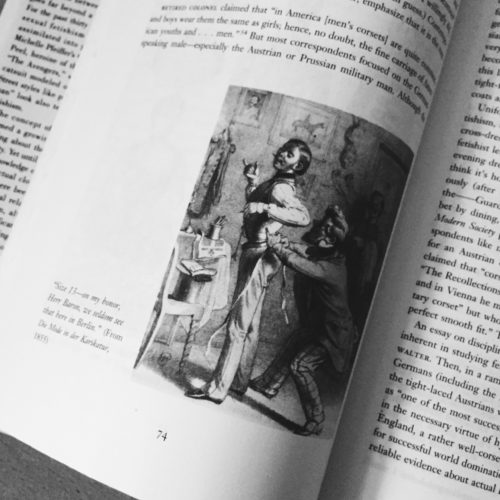The hyper-feminised silhouette produced as a result of corsetry is not one often associated with the notion of a male wearer. The corset acted as a means to drastically cinch the waist, lift and enlarge the bust as well as operating as a means to contour the hip and natural curve of the female body. In exaggerating the typically idealised ‘hour-glass’ silhouette it becomes almost unfathomable to think of the male body in relation to these traditionally feminised proportions.
As Valerie Steele argues in her book Fetish: Fashion, Sex and Power however, corsetry and the male body have a long and interesting history. Steele first discusses a common theme amongst male corset-wearers: the underlying sense of masochistic pleasure derived from the restrictions of tight-lacing. She details how, historically, many men would borrow their wife of sister’s corset and thus ask to be laced into it. The desire to be submissive toward a dominant woman is certainly an interesting concept in relation to male corsetry however, it is much too limiting a view to take when considering the complexities of corset-wearing in the modern era.
Mr Pearl, a renowned tight-lacer, is quoted within Steele’s book in stating that he does not wear corsets in an attempt to be like a woman. For Pearl, corsetry is representative of control and the discipline one needs to wear such a garment. The corset dictates the way in which one behaves; movements are restricted and posture is refined. As the corset provides support for Mr Pearl’s spine it metamorphoses into and becomes his spine, thus providing the structure and discipline that he desires in everyday life. The corset becomes a second-skin for Pearl, acting as a marker for his identity.

These notions of structure, discipline and identity factor into Steele’s discussion of the use of corsets within military uniforms. She describes Austrian officers who tight-laced as a component of their military dress. In this sense it is clear to see how Mr Pearl’s association of tight-lacing and discipline manifests itself. The military is often seen as being affiliated with extreme restraint and regulation. It therefore seems appropriate that military men might find pleasure in wearing a garment that imposed rules and restraints upon the body to maintain orderliness and posture. Within this discussion of corsetry as a means of imposed discipline however, lies an interesting observation as to how the corset can actually promote a masculine silhouette. Although corsets have predominantly been used to maintain the ideally feminine ‘hour-glass’ shape, the corset can also bee seen as exaggerating inherent masculinity. When contoured to a male body, the corset cinches the waist, elongates the torso and broadens the shoulders; features often seen as being ideally masculine. While the corset may give the illusion of curves on a female body, it can actually produce harsh and angular lines within the male silhouette; a harshness that, I argue, exaggerates masculinity and the idealised male form. Whether male corset-wearers are expressing a masochistic desire for female domination or enacting a need for order and discipline, I believe there is no doubt that corsets act as a means to exaggerate the idealised masculine physique rather than transposing that of the feminine onto the male body.
By Niall Billings
Further Reading:
Valerie Steele, Fetish: Fashion, Sex and Power, 1996










